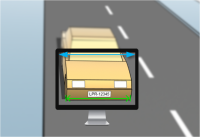Image resolution
Image quality and resolution is important for a successful license plate recognition. On the other hand, if the video resolution is too high, the CPU might be overloaded with the risk of skipped or faulty detections. The lower you can set the acceptable resolution, the better CPU-performance and the higher detection rate you get.
In this example we explain how to do a simple image quality calculation and find a suitable resolution for LPR. The calculation is based on the width of a car.
We estimate that the horizontal width is 200 cm/78 inches, as we assume the width of a standard car is 177 cm/70 inches, and besides that we add ~10% for the extra space. You can also do a physical measuring of the area of interest if you need to know the exact width.
The recommended resolution of the stroke thickness is 2.7 pixels/stroke, and the physical stroke thickness is 1 cm for a European plate and 0.27 inches for a US plate. This gives the following calculation:
Calculation for European plates in cm
200 × 2.7 ÷ 1 = 540 pixels
Recommended resolution = VGA (640×480)
Calculation for US plates in inches
78 × 2.7 ÷ 0.27 = 780 pixels
Recommended resolution = SVGA (800×600)
Because US plates use a font with a narrow stroke, a higher resolution is needed than for European plates.
Common video resolutions
|
Name |
Pixels (width × height) |
|---|---|
|
QCIF |
176×120 |
|
CIF |
352×240 |
|
2CIF |
704×240 |
|
VGA |
640×480 |
|
4CIF |
704×480 |
|
D1 |
720×576 |
|
SVGA |
800×600 |
|
XGA |
1024×768 |
|
720p |
1280×1024 |


